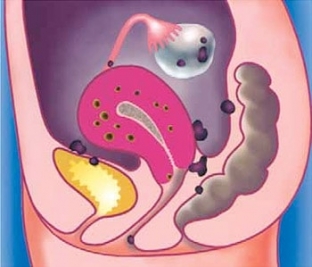Adenomyosis affects women of the most active social age - usually after about 30 years. Occasionally, this disease is congenital, but most often it develops as a type of endometriosis and belongs to estrogen-dependent diseases. A feature of adenomyosis is the soreness of its manifestations. When the endometrium, for various reasons, grows into the uterine muscle tissue, foci of inflammation form and the contractility of the uterus is disturbed, leading to extremely painful periods. Signs of adenomyosis should be a reason for the doctor to conduct appropriate research and help the woman get rid of the pain.
Signs of adenomyosis and their relationship with the causes of the disease
Signs of adenomyosis are directly related to the development of the pathological process. Since the essence of the disease is the germination of the endometrium deep into the underlying muscle layers of the uterus, and this disease itself is hormone-dependent, the main signs by which the doctor can suggest the development of adenomyosis in the patient are very severe pain and bleeding during menstruation. This is due to irritation of the nerve endings, a violation of the contractile functions of the damaged walls of the uterus, the appearance of adhesions.
The most characteristic signs indicating the development of adenomyosis are the following:
- heavy periods, spotting or even bleeding in the middle of the cycle, severe PMS;
- severe pain before and during menstruation, pain may radiate to the perineum or groin, occur during intercourse;
- infertility, miscarriage;
- iron deficiency anemia, neuroses, psychological disorders.
Today, doctors note that there are more and more patients with signs of adenomyosis. Perhaps it's all about better diagnostic methods, but the reason may be a decrease in immunity in women.
Signs of adenomyosis and features of the course of menstruation
The main symptom that patients with suspected adenomyosis complain about is very profuse bleeding during menstruation, and they are accompanied by very severe pain. Often, pain and spotting occur a couple of days before the onset of menstruation and persist for 2-3 days after it ends. Menstruation is long - for seven or more days, clots can be seen in the released blood. Bloody smears or even quite distinct bleeding can disturb the patient in the middle of the cycle, becoming an important diagnostic sign of adenomyosis.
 If the foci of germination of the endometrium deep into the uterus are very numerous, there are many adhesions and inflammatory foci are localized in the isthmus, then the pain is especially strong, not only during menstruation, but also during sexual contact, radiating to the groin, to the perineum.
If the foci of germination of the endometrium deep into the uterus are very numerous, there are many adhesions and inflammatory foci are localized in the isthmus, then the pain is especially strong, not only during menstruation, but also during sexual contact, radiating to the groin, to the perineum.
Problems with childbirth and signs of adenomyosis
Adhesions caused by damage to the fallopian tubes in adenomyosis often cause a violation of the reproductive function of a woman, and this can be another important sign of adenomyosis. If adhesions interfere with the free passage of the egg through the fallopian tubes, the patient is at risk of infertility.
In addition, since adenomyosis disrupts the structure of the endometrium, develops an inflammatory process and increases the tone of the myometrium, it is difficult for the egg to attach to the uterine wall and stay on it. This leads to spontaneous miscarriages.
Neurosis, anemia and other disorders as signs of adenomyosis
Frequent fainting and dizziness, pale skin and shortness of breath on the background of painful menstruation are another important sign of adenomyosis. Abundant blood loss leads to the development of iron deficiency anemia, which often accompanies adenomyosis, causing, among other things, frequent colds and exacerbations of chronic diseases.
Pain and severe premenstrual syndrome cause neurosis in women and significantly impair the quality of life.
Thus, the signs of endometriosis appear clearly enough for the doctor to have reason to prescribe additional studies if necessary and start treating this disease.






Add a comment